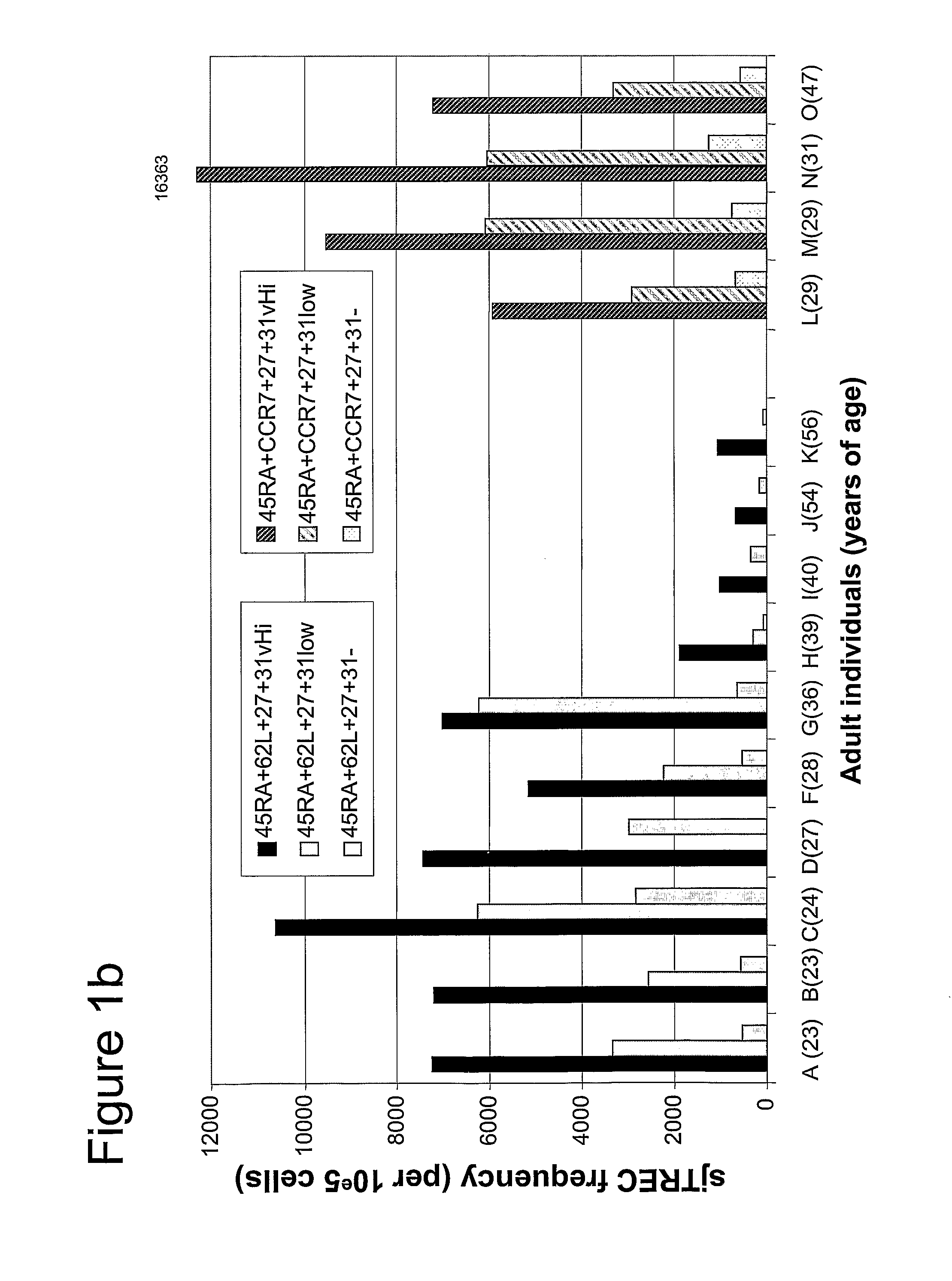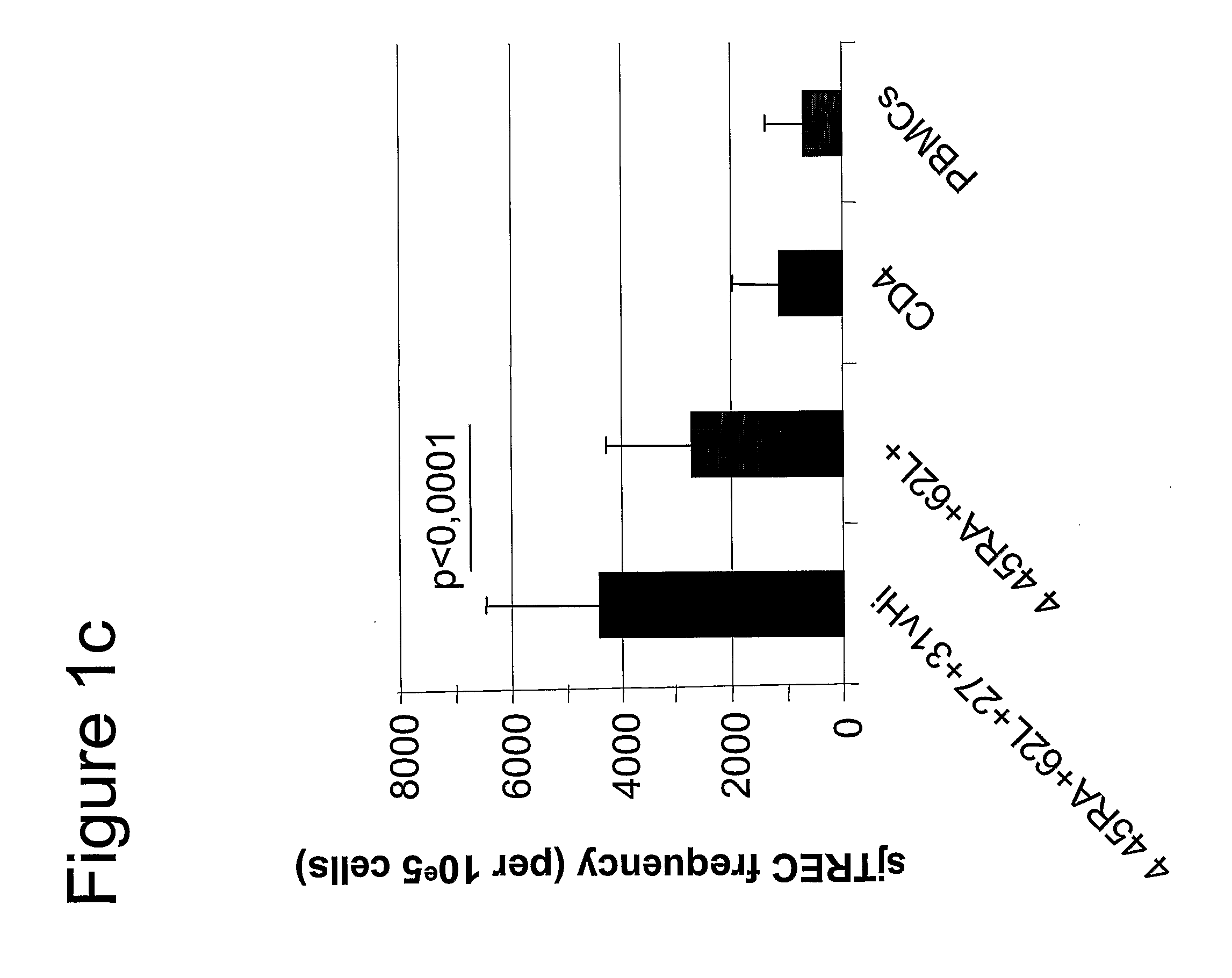Methods To Identify, Prepare, And Use Naive T Cell Recent Thymic Emigrants
a technology of thymic emigrants and t cells, applied in the field of methods to identify, quantify and purify recent thymic emigrants, can solve the problems of difficult sorting and functional characterization of rte, failure to provide convincing data that compared, and limited purity of the isolated population
- Summary
- Abstract
- Description
- Claims
- Application Information
AI Technical Summary
Benefits of technology
Problems solved by technology
Method used
Image
Examples
example 1
Isolation of PBMCs from Blood Samples
[0044]Blood and leukapheresis samples were obtained from healthy adult donors. Samples were obtained with the informed consent of the subjects and according to the guidelines of the bioethical committee of Centre hospitalier de l'Université de Montreal (CHUM) and McGill University Health Center (MUHC).
[0045]PBMCs were obtained from blood samples using density gradient sedimentation with Ficoll Paque Plus™ (Amersheam Bioscience). Cells were washed twice with PBS 2% FCS before staining with mAbs for flow cytometry.
example 2
Isolation of Thymocytes from Thymus Samples
[0046]Pediatric thymic tissues were sampled from children undergoing elective cardiac surgery from Saint-Justine Hospital as well as CHEO, with the informed consent of the child's parents and according to the guidelines of the bioethical committee of Centre hospitalier de l'Université de Montreal (CHUM) and Research Ethics Board of the Children's Hospital of Eastern Ontario. Following mechanical dissociation of thymic tissue using cell strainers (Falcon), isolated thymocytes were harvested and stained.
example 3
Cell Surface Phenotying and Sorting by Flow Cytometry
[0047]PBMCs. Freshly isolated cells were stained simultaneously with the following mAbs : FITC labeled anti-CD31(BD Pharmingen), PE labeled anti-CD27(BD Pharmingen), PECy5 labeled anti-CD45RA(BD Pharmingen), PECy7 labeled anti-CD3(BD Pharmingen), APC labeled anti-CD62L(BD Pharmingen), APC-Cy7 labeled anti-CD4 (BD Pharmingen) and ECD labeled anti-CD8 (Coulter). In the event of phenotyping, the cells were analysed by 7-color flow cytometry with the FACS LSR II™ (Becton Dickinson) using FACSDiVa™ (Becton Dickinson) software. Previously isolated cells and frozen cells were thawed and stained simultaneously with the following mAbs: PE labeled anti-CD31 (BD Pharmingen), PECy5 labeled anti-CD45RA(BD Pharmingen), PECy7 labeled anti-CCR7 (BD Pharmingen), APC labeled anti-CD3(BD Pharmingen), APC-Cy7 labeled anti-CD27 (BD Pharmingen) Alexa 700 labeled anti-CD4 (BD Pharmingen), and ECD labeled anti-CD8 (Coulter). Seven-color cell sorting was ...
PUM
| Property | Measurement | Unit |
|---|---|---|
| time | aaaaa | aaaaa |
| frequency | aaaaa | aaaaa |
| cell adhesion | aaaaa | aaaaa |
Abstract
Description
Claims
Application Information
 Login to View More
Login to View More - R&D
- Intellectual Property
- Life Sciences
- Materials
- Tech Scout
- Unparalleled Data Quality
- Higher Quality Content
- 60% Fewer Hallucinations
Browse by: Latest US Patents, China's latest patents, Technical Efficacy Thesaurus, Application Domain, Technology Topic, Popular Technical Reports.
© 2025 PatSnap. All rights reserved.Legal|Privacy policy|Modern Slavery Act Transparency Statement|Sitemap|About US| Contact US: help@patsnap.com



